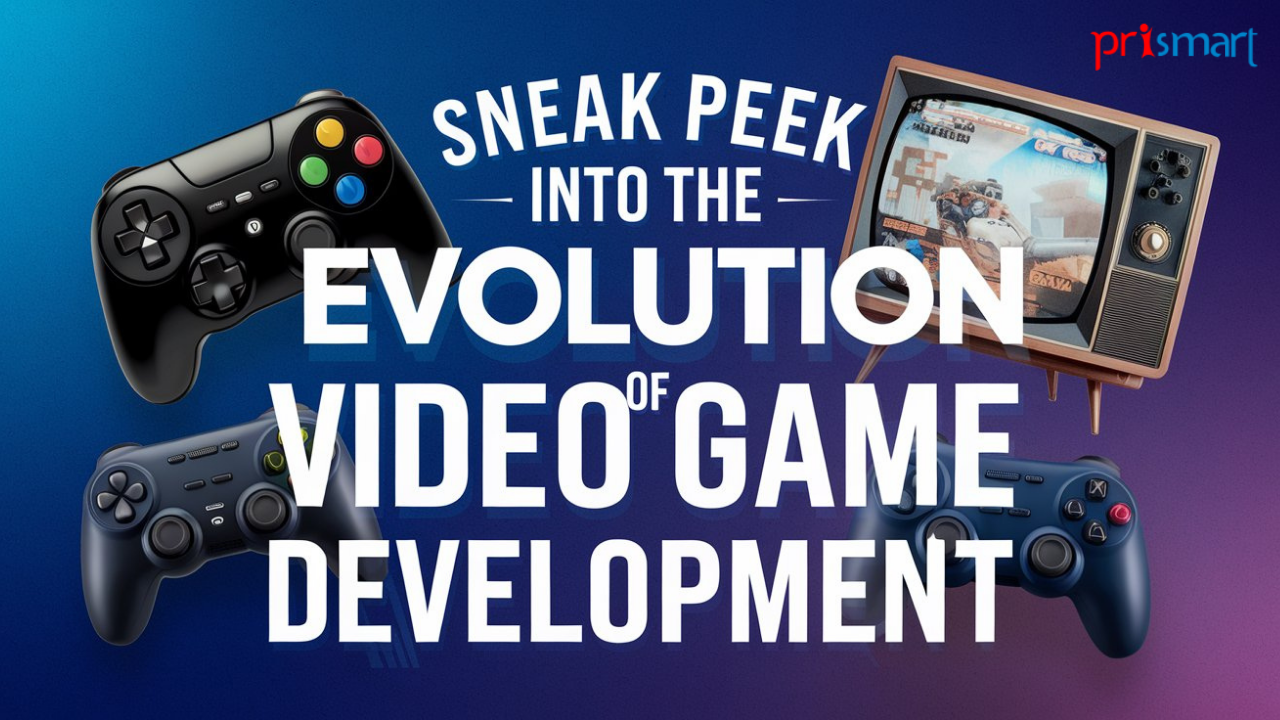Video Games have come a long way from their pixelated beginnings due to technological advancements. Central to this transformation is CGI (Computer-Generated Imagery), which has made it possible to create visually stunning images, animations, and special effects using the latest cutting-edge tools and technologies. With rapid advancements in technology, 3D artists and game developers have pushed the boundaries of visual storytelling and developed captivating visual masterpieces.
In this blog post, we’ll dive into the fascinating history and evolution of CGI in video games.
A Brief Overview of the History of Video Games
The history of video games can be traced back to the days of arcade games and home consoles that relied on Pixel Art. Arcade games like Pong, Boot Hill, and Gotcha featured simple and monochromatic pixel graphics. As technology evolved, games like Namco’s Galaxian, Pac-Man, Space Invaders, and Super Mario Bros. used more attractive visuals with vibrant colours and different shapes. However, they had limited colour palettes, low resolutions, simple and block graphics, and relied on sprites and tiles for creating characters and environments.
Further came the era of 16-bit consoles like Super Nintendo and Sega Genesis. These consoles offered more colours, larger sprites, and visual effects. Games such as Final Fantasy VI, Sonic the Hedgehog, and Donkey Kong Country showcased this new generation of consoles with detailed sprites, vibrant colours, and immersive worlds.
A major shift in game development came with CGI. This technology enabled detailed and realistic graphics in video games to enhance the overall gaming experience and engage them. Developers began using 3D computer graphics software Maya to create stunning 3D animations, realistic environments, and characters.
The Evolution of CGI in Video Gaming

Computer-generated imagery (CGI) is the use of computer software to create realistic characters, objects, and environments. Visionaries like Ivan Sutherland and Ed Catmull set the stage for this breakthrough in 3D graphics technology. Further, pioneering artists like Manfred Mohr and Vera Molnar integrated algorithms that changed the boundaries of visual storytelling.
Besides video games, CGI made an indelible impact on film production, with Steven Spielberg’s “Jurassic Park” (1993) becoming an iconic movie with its introduction of lively and animated dinosaurs. CGI was utilized in James Cameron’s Titanic (1997), the Matrix (1999), and Avatar (2009) to produce stunning visuals that changed the way stories were visually narrated. Pixar’s Toy Story (1995) won the hearts of audiences due to its astounding use of CGI and became the first fully CGI movie.
The 8-bit 2D Era (1972-1984)
- Video games utilized basic 2D sprite-based graphics
- Resolution of Arcade games: 320*240 pixels
- Resolution of NES games: 256*240 pixels
- Sega Master System; 256*192 pixels
- Backgrounds designed by repeating tile patterns
- Sprites: 8*8 or 16*16 block
- Limited colours. Only 2-16 colours for full screen
- Bright solid colours
- Sharp pixelation
The 16-bit Era (1985-1994)
- Detailed sprite-based graphics and visual effects
- 16-bit consoles
- Larger sprites, Higher resolution, Multiple colours
- New features like Scaling, Rotation, Parallax effects, Dynamic lighting, Transparency effects, and liquid physics
- Super NES: 256×224 to 512×448 pixels
- Sega Genesis: 320×224 to 640×448 pixels
- Animation-based Gameplay
The 3D Graphics Era (1993-1996)
- Introduction of consoles like PlayStation and Nintendo 64 and 3D-capable GPU chips
- 3D-capable GPU chips for real-time polygon rendering
- Development of gameplay mechanics like platforming, puzzle-solving, and exploration
- Low polygon counts, low-resolution textures, No lighting or shading effects
- Game: Starfox (SNES) utilised simple 3D models and environments at 3–15 FPS.
- Virtua Fighter (Arcade) used basic texture-mapped 3D characters
- Super Mario 64 (N64) became the first fully 3D Mario game with free camera control
The 6th Generation Era (1997-2005)
- Introduction of home consoles like Dreamcast, PS2, and Xbox.
- High polygon counts, advanced lighting and shading, and texture filtering through mipmapping.
- Resolutions: 640*480 and beyond.
- Development of detailed normal maps, early per-pixel lighting, and shadow techniques like heat haze and reflective water.
The Cinematic Pre Rendered Graphics Era (1997-2006)
- Utilizing FMW (full motion video), pre rendered CGI backgrounds, Quick Time Events (QTEs), and 3D rendered backgrounds.
- Live-action video clips popularized by Night Trap (1992)
- Scripted in-game actions for visual spectacle
- Games: Resident Evil, Final Fantasy VII, and Soul Calibur
HD Gaming (2005)
- Introduction of Xbox 360, PF3, and modern PCs
- HD 720p and 1080p gaming
- High-definition resolutions, Advanced lighting engines, photorealistic textures, real-time shadow mapping, and HDR lighting
- Complex engines like Unreal 3 for dynamic lighting
- Higher memory budgets for photorealistic textures
- Detailed normal and specular maps for high-complexity
- Filters like cinematic tone mapping, depth of field, motion blur, and more
The Current State of CGI in Video Games
- Photogrammetry for realistic environments
- PBR – Physically based rendering for realistic materials and lighting
- Ray tracing for reflections, shadows, and lighting effects
- Introduction of 4K gaming with PlayStation 4 Pro, Xbox One X, PlayStation 5, Xbox Series X
- Advanced rendering techniques like ray tracing, and global illumination.
- Character realism with motion capture and facial animation.
- Integration of AR in Video Gaming with AR headsets like HoloLens
- Games: The Last of Us Part II, Red Dead Redemption 2, Cyberpunk
- Convergence of video games in films, animation, and VR
The Future of Video Gaming
- With the evolution of CGI, video games will be more realistic, immersive, and engaging than ever.
- More realistic lighting, shadows, and reflections with Ray tracing and 8K resolution.
- AI tools will be more adopted to generate environments and characters.
- Games will approach photorealism, creating completely lifelike experiences.
- More immersive Virtual reality gaming with Oculus Rift, HTC Vive, and PlayStation VR headsets
- Integrating AI, machine learning, and real-time rendering
- Cloud gaming and cloud computing
Benefits of using CGI in Video Gaming

Realistic Appeal: CGI in video games helps create lifelike environments and realistic characters with its advanced rendering techniques, such as real-time ray tracing. Moreover, it has also enhanced the player’s gaming experience with CGI special effects.
Immersive and Engaging: Using CGI in video games boosts players’ engagement with their realistic environments and characters. The entire game environment is so lively and real that it increases players’ interest in gaming. Also, with VR in video gaming, it has become possible for players to experience the game in real time.
More Creativity: As compared to traditional methods, CGI in video games has allowed game developers to push the boundaries of their creative horizons and think outside the box. They can create fantastical creatures, worlds, and environments with new and latest software.
Great Output: No more tedious hours of working! CGI has proved to be an asset in improving game efficiency by speeding up the work. Also, with new tools and AI in animation, it has become possible for 3D artists to achieve maximum efficiency within a short time.
The Best CGI Animation Studio
In this digital era, it is important to hire a CGI animation studio for your multimedia needs like animated 3D series: TV or Web, shorts, films, commercials, live-action videos, or anything else. CGI is a groundbreaking technology that has the potential to change the game for you with more audience engagement, higher downloads, and licensing.
Prismart is one of the best CGI animation studios in New Delhi and has been catering to clients for over a decade. The company has a dedicated team of 150+ professionals, all experts in their respective fields, who are driven to hard work and results. The company is known for its fastest turnarounds, affordable budget, transparency, and client satisfaction.




